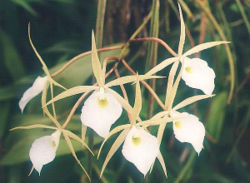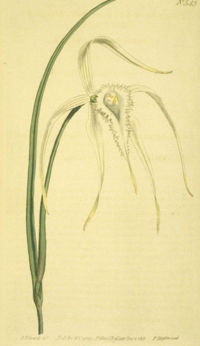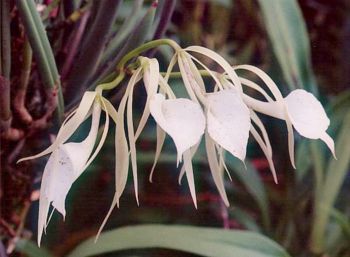Brassavola
| Brassavola {{{status}}} Fossil range: {{{fossil_range}}}
| ||||||||||||||||||||||||||||||||||||||||||||||||||||||||||||||||||
|---|---|---|---|---|---|---|---|---|---|---|---|---|---|---|---|---|---|---|---|---|---|---|---|---|---|---|---|---|---|---|---|---|---|---|---|---|---|---|---|---|---|---|---|---|---|---|---|---|---|---|---|---|---|---|---|---|---|---|---|---|---|---|---|---|---|---|
 Brassavola flagellaris | ||||||||||||||||||||||||||||||||||||||||||||||||||||||||||||||||||
| Plant Info | ||||||||||||||||||||||||||||||||||||||||||||||||||||||||||||||||||
| ||||||||||||||||||||||||||||||||||||||||||||||||||||||||||||||||||
| Scientific classification | ||||||||||||||||||||||||||||||||||||||||||||||||||||||||||||||||||
| ||||||||||||||||||||||||||||||||||||||||||||||||||||||||||||||||||
| [[{{{diversity_link}}}|Diversity]] | ||||||||||||||||||||||||||||||||||||||||||||||||||||||||||||||||||
| {{{diversity}}} | ||||||||||||||||||||||||||||||||||||||||||||||||||||||||||||||||||
| Binomial name | ||||||||||||||||||||||||||||||||||||||||||||||||||||||||||||||||||
| {{{binomial}}} | ||||||||||||||||||||||||||||||||||||||||||||||||||||||||||||||||||
| Trinomial name | ||||||||||||||||||||||||||||||||||||||||||||||||||||||||||||||||||
| {{{trinomial}}} | ||||||||||||||||||||||||||||||||||||||||||||||||||||||||||||||||||
| Type Species | ||||||||||||||||||||||||||||||||||||||||||||||||||||||||||||||||||
| {{{type_species}}} | ||||||||||||||||||||||||||||||||||||||||||||||||||||||||||||||||||
| Species | ||||||||||||||||||||||||||||||||||||||||||||||||||||||||||||||||||
| See text. | ||||||||||||||||||||||||||||||||||||||||||||||||||||||||||||||||||
| [[Image:{{{range_map}}}|{{{range_map_width}}}|]] | ||||||||||||||||||||||||||||||||||||||||||||||||||||||||||||||||||
| Synonyms | ||||||||||||||||||||||||||||||||||||||||||||||||||||||||||||||||||
| {{{synonyms}}} |
Brassavola is a genus of 20 orchids (family Orchidaceae). The name comes from the Venetian nobleman and physician Antonio Musa Brassavola. The genera Eudisanthema Neck. ex Post & Kuntze, Lysimnia Raf. and Tulexis Raf. are synonyms of Brassavola.
These species are native to the lowlands of Central America and tropical South America. They are epiphytes, and a few are lithophytes. A single, apical and succulent leaf grows on an elongated pseudobulb.

The orchid yields a single white or greenish white flower, or a raceme of a few flowers. The five greenish sepals are narrow and long. The base of the broad fringed lip enfolds partially the column. This column has a pair of falciform ears on each side of the front and contains twelve (sometimes eight) pollinia.
Most Brassavola orchids are very fragrant, attracting pollinators with their citrusy smell. But they are only fragrant at night, in order to attract the right moth.
In 1698 Brassavola nodosa was the first tropical orchid to be brought from the Caribbean island Curaçao to Holland. Thus began the propagation of this orchid and the fascination for orchids in general.
Species
- Brassavola acaulis (C. America). Belize
- Brassavola cucullata : Hooded Brassavola, Daddy Longlegs Orchid (Mexico to N. South America).
- Brassavola duckeana (Brazil).

- Brassavola fasciculata (Brazil).
- Brassavola filifolia (Colombia).
- Brassavola flagellaris (Brazil).
- Brassavola fragans (Brazil).
- Brassavola gardneri (French Guiana, Brazil).
- Brassavola gillettei (Trinidad).
- Brassavola grandiflora (C. America to Colombia).
- Brassavola harrisii (Jamaica).
- Brassavola martiana (S. Trop. America).
- Brassavola nodosa Lady-of-the-night Orchid (Mexico to Trop. America). Belize
- Brassavola reginae (Brazil ).
- Brassavola retusa (Venezuela, N. Brazil to Peru).
- Brassavola revoluta (Brazil).
- Brassavola rhomboglossa (WC. & S. Brazil).
- Brassavola subulifolia (Jamaica).
- Brassavola tuberculata (Brazil to Peru and NE. Argentina).
- Brassavola venosa (SE. Mexico to C. America).
Brassavola is in the same alliance as the genera Cattleya and Laelia. They have been therefore used extensively in hybridization.
Some Hybrids:
- Brassavola Little Stars
- Brassavola David Sanders, a primary hybrid between Brassavola cucullata and Rhyncholaelia digbyana. Rhyncolaelia digbyana was formerly classified as a Brassavola, and its hybrids have not been reclassified.
- Brassolaelia Yellow Bird (Brassolaelia Richard Mueller x Brassavola nodosa)